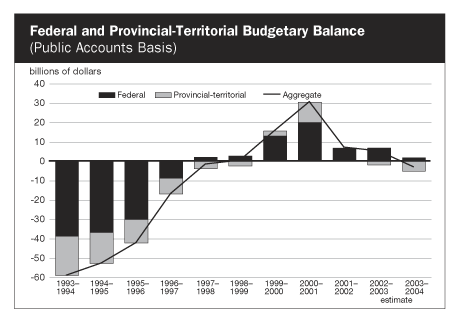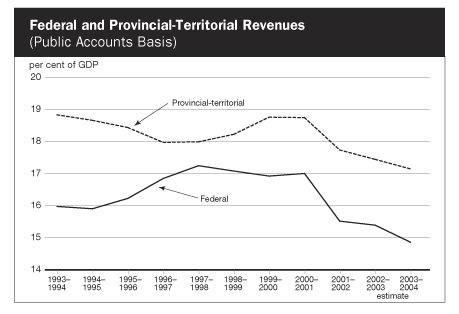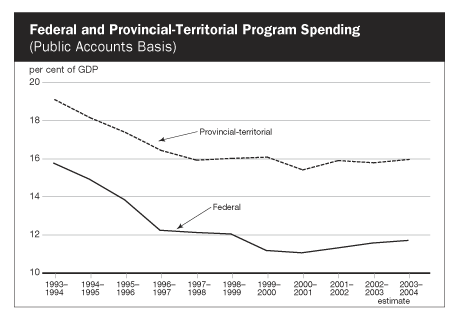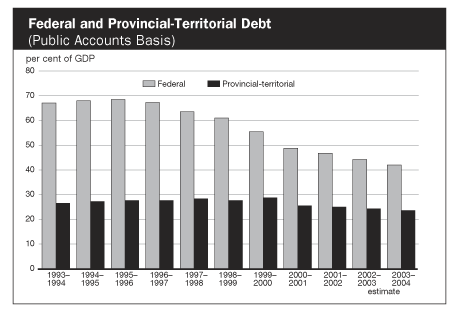![]()
Budget 2004 - Budget Plan
- Table of Contents - Previous
- Next -
Annex 2
Fiscal Performance of Canada's Federal-Provincial-Territorial Government
Sector
Introduction
- This annex presents the fiscal situation of the aggregate federal-provincial-territorial government sector, based on Public Accounts data, as published by the individual governments.[1]
- At the federal level, a $1.9 billion surplus is estimated for 200304, down from a surplus of $7.0 billion in 200203. A deficit of $5 billion is expected for the provincial-territorial government sector,[2] up from a deficit of $1.8 billion in 200203. As a result, after five consecutive surpluses, the aggregate federal-provincial-territorial sector is expected to post a $3.1 billion deficit in 200304.
- The revenue-to-GDP (gross domestic product) ratio continued to decline in 200304 at both the federal and provincial-territorial government levels, partly reflecting tax cuts announced in past budgets and weak income tax collections. Provincial-territorial revenues continue to exceed federal revenues.
- Total spending as a percentage of GDP was relatively stable at both the federal and provincial-territorial government levels in 200304. For both levels of government, the ratios were well below levels observed in 199394.
- Debt-to-GDP ratios continue to fall. It is estimated that the federal debt-to-GDP ratio declined by 26.4 percentage points from its peak of 68.4 per cent in 199596 to 42 per cent in 200304. Over the same period, the aggregate provincial-territorial debt-to-GDP ratio is estimated to have declined by 4.1 percentage points to 23.6 per cent.
The total federal-provincial-territorial government sector is expected to be in a deficit position, in aggregate, in 200304

- After posting five consecutive surpluses, the federal-provincial-territorial governments are projecting an aggregate deficit of $3.1 billion, or 0.2 per cent of GDP, in 200304, an $8.2-billion deterioration from 200203. A surplus of $1.9 billion projected for the federal government level is more than offset by the projected provincial and territorial governments deficit of $5 billion.
The combined provincial-territorial sector is expected to post a deficit for the second consecutive year
Provincial-Territorial Budgetary Balances
(Public Accounts Basis)
|
|
|||||
| 199394 | 200001 | 200102 | 2002031 | 2003041 | |
|---|---|---|---|---|---|
|
|
|||||
|
(millions of dollars) |
|||||
| Newfoundland and Labrador | -341 | -350 | -468 | -691 | -827 |
| Prince Edward Island | -71 | -12 | -17 | -84 | -53 |
| Nova Scotia | -546 | 147 | 113 | 32 | -22 |
| New Brunswick | -266 | 43 | 79 | 1 | 8 |
| Quebec | -4,923 | 427 | 22 | -528 | 0 |
| Ontario | -11,202 | 1,902 | 375 | 117 | -5,621 |
| Manitoba | -431 | 41 | 63 | 4 | 5 |
| Saskatchewan | -272 | 58 | 1 | 1 | 0 |
| Alberta | -1,371 | 6,571 | 1,081 | 2,134 | 3,327 |
| British Columbia | -899 | 1,503 | -1,187 | -2,680 | -1,644 |
| Yukon | 15 | 35 | -21 | -6 | -15 |
| Northwest Territories | -22 | 118 | 120 | -34 | -83 |
| Nunavut | | -12 | -47 | -22 | -50 |
| Total | -20,329 | 10,471 | 114 | -1,757 | -4,976 |
|
|
|||||
| 1 Estimates. | |||||
- A $5-billion deficit is estimated for the aggregate provincial-territorial sector in 200304 (equivalent to 0.4 per cent of GDP), largely reflecting sizeable deficits in Ontario and British Columbia. Although five provinces are projecting balanced budgets or better, only Alberta is forecasting a significant surplus this year.
- The increase in the expected aggregate provincial-territorial deficit between 200203 and 200304 is primarily due to the deterioration in Ontarios fiscal position.
Total government revenues as a share of GDP continued to decline in 200304

- In 200304 it is estimated that revenues as a percentage of GDP declined at both the federal and provincial-territorial levels for the third consecutive year.
- Since 200001 federal revenues as a share of GDP have declined by 2.1 percentage points to an estimated 14.9 per cent, mainly reflecting reductions in personal and corporate income taxes and employment insurance premiums as well as weaker tax collections resulting from slower economic growth. Provincial-territorial revenues as a percentage of GDP have declined from 18.7 per cent in 200001 to an estimated 17.1 per cent in 200304, primarily reflecting tax reductions announced in the 2000 and 2001 provincial-territorial budgets.
- Provincial-territorial revenues (including federal transfers such as the Canada Health and Social Transfer and equalization) continue to exceed federal revenues.
Although program spending has increased slightly as a share of GDP in recent years, it remains well below the level of 10 years ago

- As a share of GDP, program spending at both levels of government has fallen sharply over the last 10 years as part of fiscal restructuring to eliminate deficits.
- From 199394 to 200304 federal program spending as a share of GDP fell from 15.7 per cent to an estimated 11.8 per cent.
- Over the same period provincial-territorial program spending, measured as a share of GDP, fell from 19.1 per cent to an estimated 15.9 per cent.
Despite the recent deterioration in budgetary balances, the debt burden continues to fall at both levels of government

- In 200304 the federal debt-to-GDP ratio is estimated to be 42 per cent, a drop of 26.4 percentage points from its peak of 68.4 per cent in 199596.
- The provincial-territorial debt-to GDP ratio is estimated at 23.6 per cent in 200304, a decline of 5.1 percentage points from its peak of 28.7 percentage points in 19992000.
- The federal debt burden remains nearly double the combined provincial-territorial debt burden.
resulting in a drop in debt-servicing charges as a per cent of revenues

- While declining over the last seven years in response to federal surpluses and debt reductions, the federal government continues to face higher debt-servicing charges than the provincial-territorial sector as a result of its larger debt burden.
- In 199596 the federal government spent 37.6 cents of every dollar of revenue on debt charges. Significant progress has been made in reducing this burden: in 2003-04 federal debt charges now consume an estimated 19.8 cents of every dollar of revenue.
- In the provincial-territorial sector an estimated 10.8 cents of every revenue dollar is spent on debt charges.
1 Does not include the financial activities of the local government sector, which comprises municipalities and school boards, or the Canada Pension Plan (CPP) and the Quebec Pension Plan (QPP). A more comprehensive picture of the total government sector is contained in Annex 3, "Canada's Financial Performance in an International Context," which includes both the local government sector and the CPP/QPP. [Return]
2 Based on data available up to March 15, 2004. [Return]
- Table of Contents - Previous - Next -
|
|
|||||
| Last Updated: 2004-03-23 | |||||